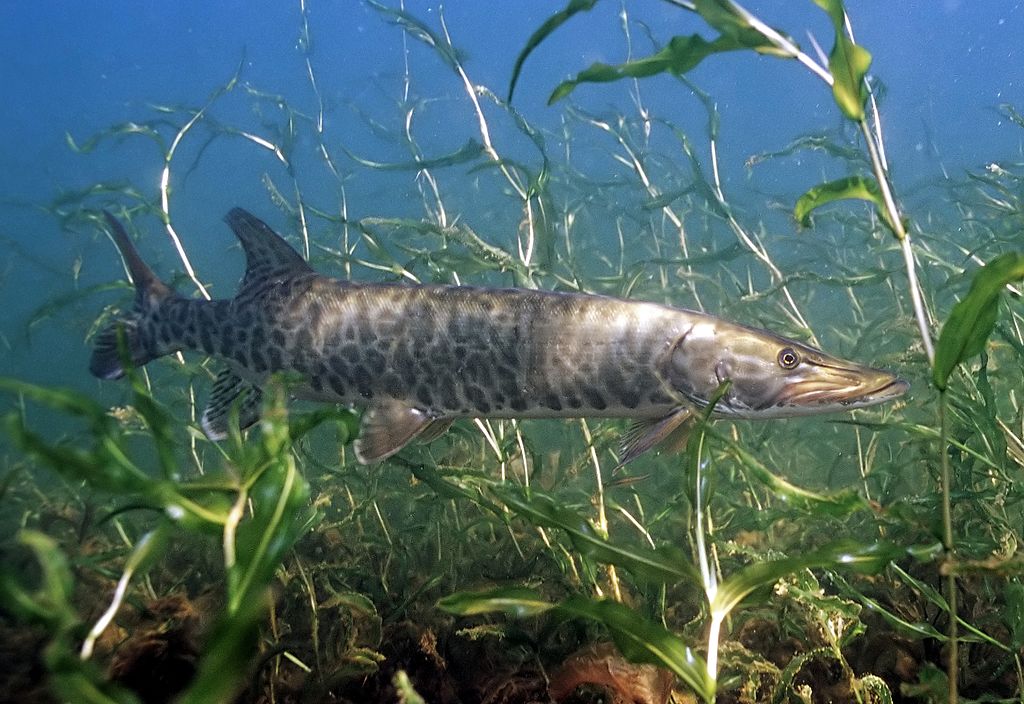
Muskellunge (Muskie)
Scientific Name: Esox masquinongy
Also known as: Muskie, Great Northern Pike, Maskinonge, Esox, Tiger Muskie
General Description
The muskellunge, commonly known as the muskie, is a large, predatory fish native to North America. Known for its elongated body, sharp teeth, and aggressive hunting style, the muskie is a highly sought-after species for trophy anglers. These fish typically range in size from 30 to 50 inches, though they can grow much larger, with some individuals reaching lengths of 60 inches or more. Muskie have a distinct appearance, with a body that is long and streamlined, a blunt head, and sharp, needle-like teeth designed for capturing and holding onto large prey.
The muskellunge’s coloration varies, but it generally features a greenish or grayish body with vertical bars or spots along its sides. These markings provide camouflage in the murky waters where muskie are often found. Their large size, strength, and predatory nature make them a thrilling catch, though they are often considered elusive, earning the muskie the nickname “fish of 10,000 casts.”
Muskies are apex predators in their ecosystems, feeding on a wide variety of fish, birds, and even small mammals. As a result, they are an important species in maintaining the balance of their habitat. Anglers who target muskies often do so for the challenge of catching this legendary fish, which is both a prize and a symbol of fishing prowess.
Where to Find Them
Muskellunge are primarily found in the northern parts of North America, particularly in the Great Lakes region, the Upper Midwest, and parts of Canada. They inhabit a variety of freshwater environments, including large lakes, reservoirs, and slow-moving rivers. Muskies are typically found in deeper waters with plenty of submerged structures, such as rocks, fallen trees, and aquatic vegetation, where they can stalk and ambush their prey. They thrive in areas with low to moderate current and prefer waters with a temperature range of 60 to 75°F.
In the wild, muskie populations are concentrated in areas where food is abundant, such as in lakes with large populations of smaller fish, including bluegill, perch, and other smaller sunfish species. These waters are often nutrient-rich and feature deep, clear areas with submerged cover. Popular muskie hotspots include the St. Lawrence River, the Mississippi River, and large northern lakes like Lake of the Woods and Lake Erie.
Muskellunge are also found in some man-made reservoirs, particularly those that have been stocked with muskies to bolster recreational fishing opportunities. These fish are often found in the shallower parts of the water during spring and fall, when they are more active and feeding aggressively. During the warmer months, they tend to move to deeper waters, where they are less accessible to anglers but still rely on structure for hunting.
Best Baits
Live Bait Options
- Large minnows (especially suckers)
- Bluegill
- Perch
- Crayfish
- Small trout
Artificial Bait Options
- Large jerkbaits
- Muskie-specific crankbaits
- Spinnerbaits
- Soft plastic swimbaits
- Topwater lures (especially large poppers)
Best Fishing Methods
Fishing for muskellunge requires patience, skill, and the right equipment, as these fish are known for being elusive and difficult to hook. The best method for targeting muskie is trolling or casting with large, heavy lures that mimic the muskie’s prey. A strong, durable rod and reel are essential due to the size and power of the fish.
Trolling is often the most effective technique, as it allows anglers to cover large areas of water while targeting deeper zones where muskies may be lurking. By using large, deep-diving crankbaits or soft plastic swimbaits, anglers can imitate the movement of smaller fish and entice muskie into striking. A common trolling speed is 2 to 3 mph, and trolling rigs should use heavy, durable line (at least 80-pound test) to handle the muskie’s strength.
Casting is another popular method for muskie fishing, particularly when targeting shallower waters or structures like submerged rocks and fallen trees. A variety of lures can be used for casting, including large jerkbaits, spinnerbaits, and topwater lures, which are particularly effective during the early morning or evening when muskies are feeding actively. Muskie-specific lures are designed to mimic the large prey that these fish hunt, and larger lures typically produce better results. Slow, deliberate retrievals and “figure-eight” patterns near the boat are proven techniques that increase the chances of a successful hook-up.
Fishing for muskellunge is often a game of patience. Since they are known for being selective and elusive, it may take many hours or even several days of fishing to hook one. Anglers must remain persistent, adapting to changing water conditions and muskie activity.
Summary
Muskellunge are a challenging and rewarding species to target, often referred to as the “fish of 10,000 casts” due to their elusive nature. Their size, strength, and predatory behavior make them a thrilling catch, and pursuing them is a test of skill and patience. Muskies are found in large, deep waters with submerged structures, where they stalk their prey. Whether fishing in natural lakes, reservoirs, or rivers, successful muskie fishing requires patience and perseverance.
The most effective methods for catching muskie are trolling with large lures or casting with heavy, specialized baits. Large jerkbaits, muskie-specific crankbaits, and topwater lures are all popular choices. Due to their size, muskie fishing requires heavy-duty rods and reels, as well as strong fishing line. Techniques like trolling at consistent speeds or casting slowly and methodically are essential for enticing strikes.
The key to muskie fishing is understanding their behavior and habitat. These fish are apex predators that require specific conditions for successful hunting, so knowing where to find them and how to present your bait is crucial. Whether you’re targeting a trophy muskie or simply enjoying the challenge, fishing for this legendary fish is an experience that every angler should have at least once.


